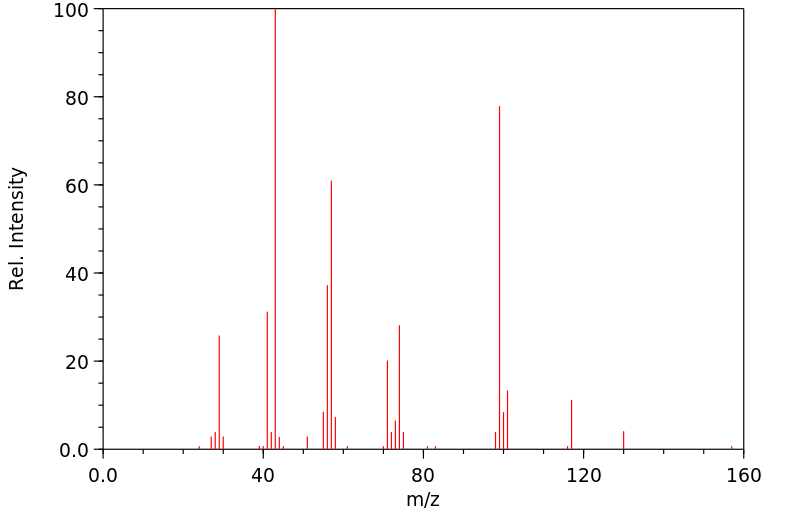2-甲基丙基4-氧代戊酸酯 | 3757-32-2
中文名称
2-甲基丙基4-氧代戊酸酯
中文别名
乙酰丙酸异丁酯
英文名称
iso-butyl levulinate
英文别名
Isobutyl 4-oxovalerate;2-methylpropyl 4-oxopentanoate
CAS
3757-32-2
化学式
C9H16O3
mdl
MFCD24390044
分子量
172.224
InChiKey
WETOYPNHZMSVFZ-UHFFFAOYSA-N
BEILSTEIN
——
EINECS
——
-
物化性质
-
计算性质
-
ADMET
-
安全信息
-
SDS
-
制备方法与用途
-
上下游信息
-
文献信息
-
表征谱图
-
同类化合物
-
相关功能分类
-
相关结构分类
物化性质
-
沸点:228°C (estimate)
-
密度:0.9669
-
LogP:1.301 (est)
-
保留指数:1183
计算性质
-
辛醇/水分配系数(LogP):1
-
重原子数:12
-
可旋转键数:6
-
环数:0.0
-
sp3杂化的碳原子比例:0.777
-
拓扑面积:43.4
-
氢给体数:0
-
氢受体数:3
安全信息
-
海关编码:2918300090
-
危险性防范说明:P261,P264,P270,P271,P280,P301+P312,P302+P352,P304+P340,P305+P351+P338,P330,P332+P313,P337+P313,P362,P403+P233,P405,P501
-
危险性描述:H302,H315,H319,H335
-
储存条件:2-8°C
SDS
反应信息
-
作为反应物:描述:2-甲基丙基4-氧代戊酸酯 生成 4-phenylhydrazono-valeric acid isobutyl ester参考文献:名称:Sah; Ma, Journal of the American Chemical Society, 1930, vol. 52, p. 4883摘要:DOI:
-
作为产物:描述:alkaline earth salt of/the/ methylsulfuric acid 在 硫酸 作用下, 生成 2-甲基丙基4-氧代戊酸酯参考文献:名称:Effects of Tower Climbing Exercise on Bone Mass, Strength, and Turnover in Growing Rats摘要:为了确定爬塔运动对骨骼质量、强度和局部周转的影响,我们将 50 只 10 周大的 Sprague-Dawley 大鼠分为五组:一组为基线对照组,两组分别为静坐组和运动组。大鼠自愿爬上 200 厘米高的塔,从塔顶的瓶子里喝水。4周后,腰椎和胫骨的骨小梁形成率(BFR/骨表面[BS])、骨量(BV/TV)和骨小梁厚度(Tb.Th)以及胫骨的骨矿物质密度(BMD)均有所增加,而破骨细胞表面(Oc.S)则有所减少。中腓骨的参数值,如总横截面积、惯性矩、骨膜矿化面(MS/BS)、矿物质附着率(MAR)、BFR/BS 和弯曲负荷都有所增加,而骨膜矿化面(MAR)则有所减少。8 周后,股骨和胫骨的骨矿物质含量(BMC)、BMD 以及股骨的弯曲负荷值均显著增加,但攀爬运动并未增加腰椎的骨矿物质含量、BMD 或压缩负荷。虽然骨膜MS/BS、MAR和BFR/BS有所增加,但骨膜内MS/BS、MAR和BFR/BS却有所减少。这些结果表明,爬山运动对股骨皮质和胫骨小梁而非椎骨小梁有益处。在股骨中段,对骨形成的影响具有部位特异性,支持机械刺激加速皮质漂移。DOI:10.1359/jbmr.2001.16.1.166
文献信息
-
Effects of a New Selective Estrogen Receptor Modulator (MDL 103,323) on Cancellous and Cortical Bone in Ovariectomized Ewes: A Biochemical, Histomorphometric, and Densitometric Study作者:Pascale Chavassieux、Patrick Garnero、Francois Duboeuf、Philippe Vergnaud、Francoise Brunner-Ferber、Pierre D. Delmas、Pierre J. MeunierDOI:10.1359/jbmr.2001.16.1.89日期:——The aims of this study performed in ewes were: (1) to confirm in this animal model the effects on bone of ovariectomy (OVX) alone or associated with Lentaron (L), a potent peripheral aromatase inhibitor, used to amplify the effects of OVX and (2) to evaluate the effects of a new selective estrogen receptor modulator (SERM; MDL 103,323) on bone remodeling. Thirty‐nine old ewes were divided into five groups: sham (n = 7); OVX (n = 8); OVX + L (n = 8); OVX + L + MDL; 0.1 mg/kg per day (n = 8); and OVX + L + MDL 1 mg/kg per day (n = 8). The animals were treated for 6 months. Biochemical markers of bone turnover (urinary excretion of type 1 collagen C‐telopeptide [CTX], serum osteocalcin [OC], and bone alkaline phosphatase [BAP]) were measured each month. Bone biopsy specimens were taken at the beginning and after death at the end of the experiment. Bone mineral density (BMD) was measured by dual‐energy X‐ray absorptiometry (DXA) on the lumbar spine and femur. OVX induced a significant increase in biochemical markers. This effect was the highest after 3 months for CTX (+156% vs. sham) and after 4 months for OC and BAP (+74% and +53% vs. sham, respectively). L tended to amplify the effect of OVX on OC and BAP. OVX induced significant increases in the porosity, eroded, and osteoid surfaces in cortical bone but no effect was observed in cancellous bone. MDL treatment reduced the bone turnover as assessed by bone markers, which returned to sham levels as well as histomorphometry both in cortical and in cancellous bone. Cancellous osteoid thickness decreased by 27% (p < 0.05), mineralizing perimeter by 81% (p < 0.05), and activation frequency by 84% (p < 0.02) versus OVX + L. Femoral and spinal BMD were increased by MDL and tended to return to the sham values. The effects of OVX on bone turnover were different on cortical and cancellous bone. These effects on cortical bone were reflected by changes in biochemical markers. MDL markedly reduces bone turnover and increases BMD suggesting that this new agent may prevent postmenopausal bone loss.本研究在母羊中进行,旨在:(1) 在这一动物模型中确认单独或联合使用强效外周芳香化酶抑制剂Lentaron(L)的卵巢切除术(OVX)对骨骼的影响,以增强OVX的效果;(2) 评估一种新的选择性雌激素受体调节剂(SERM;MDL 103,323)对骨重建的影响。研究共纳入39只老母羊,分为五组:假手术组(n = 7);OVX组(n = 8);OVX + L组(n = 8);OVX + L + MDL 0.1 mg/kg每日至(n = 8);OVX + L + MDL 1 mg/kg每日至(n = 8)。动物治疗持续了6个月。每月测量骨代谢的生化标记物(尿中1型胶原C末端肽[CTX]、血清骨钙素[OC]和骨碱性磷酸酶[BAP])。在实验开始时及结束时对死亡后的骨活检标本进行取样。通过双能X射线吸收法(DXA)测量腰椎和股骨的骨矿密度(BMD)。OVX显著提高了生化标记物的水平。这一效应在3个月后CTX达到最高值(+156%对比假手术组),在4个月后OC和BAP分别增加了74%和53%。L倾向于增强OVX对OC和BAP的影响。OVX使皮质骨的孔隙度、侵蚀面和骨样面显著增加,但海绵骨未观察到影响。MDL治疗降低了骨代谢,生化标记物恢复至假手术组水平,组织形态学分析显示皮质和海绵骨均如此。海绵骨骨样厚度减少了27%(p < 0.05),矿化边缘减少了81%(p < 0.05),激活频率减少了84%(p < 0.02),相较于OVX + L组。MDL使股骨和脊柱的BMD增加,并趋向恢复至假手术组水平。OVX对骨代谢的影响在皮质骨和海绵骨上有所不同。这些对皮质骨的影响体现在生化标记物的变化上。MDL显著降低了骨代谢并增加了BMD,提示该新剂可能预防绝经后骨质流失。
-
Facile Synthesis of Optically-Active γ-Valerolactone from Levulinic Acid and Its Esters Using a Heterogeneous Enantio-Selective Catalyst作者:Tsutomu Osawa、Yuya TanabeDOI:10.1007/s10562-017-2291-2日期:2018.3levulinic acid and its esters. A tartaric acid-NaBr-modified nickel catalyst produced the optically-active γ-valerolactone with a 60% enantiomeric excess (ee), almost quantitative conversion and chemoselectivity. The synthesis of the optically-active γ-valerolactone using the enantio-selective heterogeneous catalyst would be promising for the large-scale industrial production from levulinic acid and its
-
Esterification of levulinic acid over Sn(II) exchanged Keggin heteropolyacid salts: An efficient route to obtain bioaditives作者:Márcio José Da Silva、Diego Morais Chaves、Milena Galdino Teixeira、Carlos Giovani Oliveira BruziquesiDOI:10.1016/j.mcat.2021.111495日期:2021.3levulinic acid), converting it to bioadditives over solid Sn(II) exchanged Keggin heteropolyacid salts. These solid catalysts are an attractive alternative to the traditional soluble and corrosive Bronsted acid catalysts. Among Sn(II) heteropoly salts, the Sn1.5PW12O40 was the most active and selective catalyst, achieving high conversions (ca. 90 %) and selectivity (90–97 %) for alkyl esters and angelica
-
Green syntheses of levulinate esters using ionic liquid 1-Methyl imidazolium hydrogen sulphate [MIM][HSO4] in solvent free system作者:Saurabh G. Kalghatgi、Bhalchandra M. BhanageDOI:10.1016/j.molliq.2019.02.053日期:2019.5synthesized by esterification of levulinic acid (LA) with n-butanol using Brønsted acidic ionic liquid [MIM][HSO4] as a catalyst in a solvent free condition. The prepared IL was characterized by FT-IR, 13C‐NMR and 1H–NMR. For optimization study, central composite design (CCD) method was employed. Design of experiments and statistical analysis is performed using Design Expert 11 software. The highest在本工作中,使用布朗斯台德酸性离子液体[MIM] [HSO 4 ]作为催化剂,在无溶剂的条件下,通过将乙酰丙酸(LA)与正丁醇酯化来合成乙酰丙酸正丁酯。制备的IL的特征在于FT-IR,13 C-NMR和1H-NMR。为了进行优化研究,采用了中央复合设计(CCD)方法。使用Design Expert 11软件进行实验和统计分析的设计。在90°C时,乙酰丙酸正丁酯的最高收率为89.6%,选择性为98.1%。观察到产物和IL的双相层,导致产物自分离。研究了变量参数变化对转化率的影响,如:LA:正丁醇摩尔比,LA:IL摩尔比和温度。获得阿累尼乌斯图,并且活化能(E a)经计算为53.16 KJ / mol。在仲丁醇,异丁醇和叔丁醇,1-戊醇和正己醇上进行了底物研究,从而提供了高产率和相应乙酰丙酸酯的选择性。催化剂被重复使用了五次,而收率没有明显降低。
-
A New Sulfonic Acid-Functionalized Organic Polymer Catalyst for the Synthesis of Biomass-Derived Alkyl Levulinates作者:Yi Tian、Ruoqi Zhang、Wenguang Zhao、Sha Wen、Yanping Xiang、Xianxiang LiuDOI:10.1007/s10562-020-03253-5日期:2020.12acid-functionalized organic polymer possessed high catalytic activity, and the yield of n-butyl levulinate reached 97.4% under the mild conditions. PDVTA-SO3H exhibited strong acidic sites and high stability, and would be well expected to be a potential candidate better than some commercial sulfonic solid catalysts for alkyl levulinates production. The catalyst had been reused without any treatment for five times and乙酰丙酸烷基酯是重要的生物基化学品,具有出色的燃料混合特性和良好的反应性。在这项工作中,成功制备并研究了一种新的带有磺酸基团的官能化含氮有机聚合物(PDVTA-SO3H),用于乙酰丙酸与醇的酯化反应生成乙酰丙酸烷基酯。结果表明,该磺酸官能化有机聚合物具有较高的催化活性,在温和条件下乙酰丙酸正丁酯的产率达到97.4%。PDVTA-SO3H 表现出强酸性位点和高稳定性,并且有望成为比一些用于生产乙酰丙酸烷基酯的商业磺酸固体催化剂更好的潜在候选者。该催化剂未经任何处理已重复使用五次,结果证明其具有工业应用潜力。一种新的磺酸官能化有机聚合物在将生物质衍生的乙酰丙酸转化为乙酰丙酸烷基酯方面表现出很高的活性。
表征谱图
-
氢谱1HNMR
-
质谱MS
-
碳谱13CNMR
-
红外IR
-
拉曼Raman
-
峰位数据
-
峰位匹配
-
表征信息
同类化合物
马来酰基乙酸
顺-3-己烯-1-丙酮酸
青霉酸
钠氟草酰乙酸二乙酯
醚化物
酮霉素
辛酸,2,4-二羰基-,乙基酯
草酸乙酯钠盐
草酰乙酸二乙酯钠盐
草酰乙酸二乙酯
草酰乙酸
草酰丙酸二乙酯
苯乙酰丙二酸二乙酯
苯丁酸,b-羰基-,2-丙烯基酯
聚氧化乙烯
羟基-(3-羟基-2,3-二氧代丙基)-氧代鏻
磷酸二氢2-{(E)-2-[4-(二乙胺基)-2-甲基苯基]乙烯基}-1,3,3-三甲基-3H-吲哚正离子
碘化镝
硬脂酰乙酸乙酯
甲氧基乙酸乙酯
甲氧基乙酰乙酸酯
甲基氧代琥珀酸二甲盐
甲基4-环己基-3-氧代丁酸酯
甲基4-氯-3-氧代戊酸酯
甲基4-氧代癸酸酯
甲基4-氧代月桂酸酯
甲基4-(甲氧基-甲基磷酰)-2,2,4-三甲基-3-氧代戊酸酯
甲基3-羰基-2-丙酰戊酸酯
甲基3-氧代十五烷酸酯
甲基2-氟-3-氧戊酯
甲基2-氟-3-氧代己酸酯
甲基2-氟-3-氧代丁酸酯
甲基2-乙酰基环丙烷羧酸酯
甲基2-乙酰基-4-甲基-4-戊烯酸酯
甲基2-乙酰基-2-丙-2-烯基戊-4-烯酸酯
甲基2,5-二氟-3-氧代戊酸酯
甲基2,4-二氟-3-氧代戊酸酯
甲基2,4-二氟-3-氧代丁酸酯
甲基1-异丁酰基环戊烷羧酸酯
甲基1-乙酰基环戊烷羧酸酯
甲基1-乙酰基环丙烷羧酸酯
甲基1-乙酰基-2-乙基环丙烷羧酸酯
甲基(2Z,4E,6E)-2-乙酰基-7-(二甲基氨基)-2,4,6-庚三烯酸酯
甲基(2S)-2-甲基-4-氧代戊酸酯
甲基(1S,2R)-2-乙酰基环丙烷羧酸酯
甲基(1R,2R)-2-乙酰基环丙烷羧酸酯
瑞舒伐他汀杂质
瑞舒伐他汀杂质
环氧乙烷基甲基乙酰乙酸酯
环戊戊烯酸,Β-氧代,乙酯







